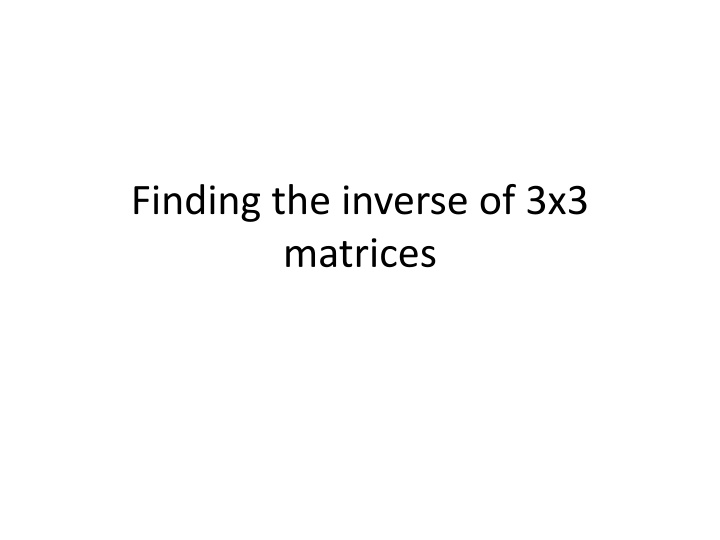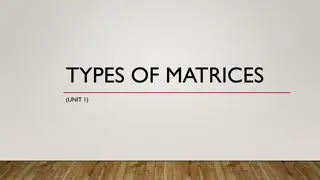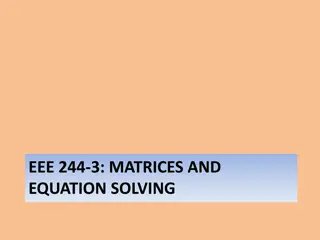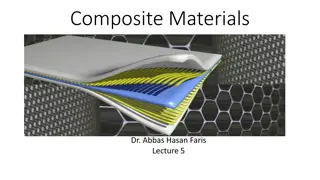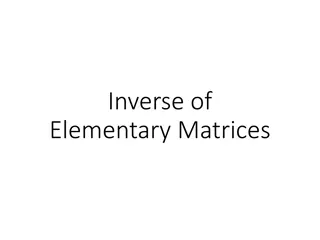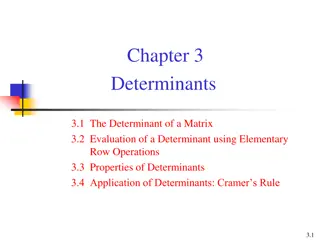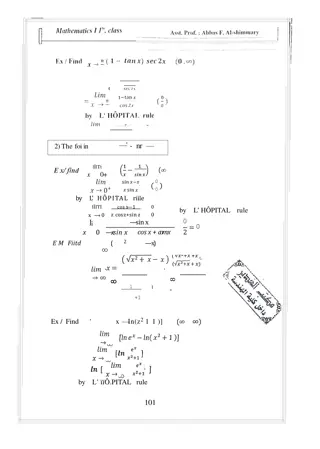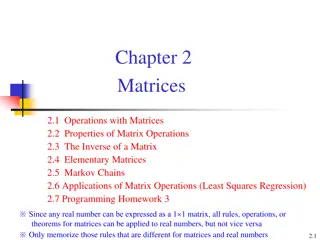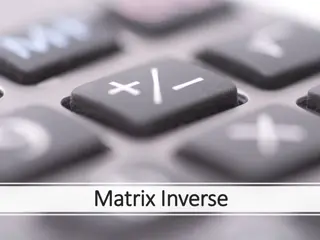Matrix Operations for 3x3 Matrices
Learn how to find the inverse of a 3x3 matrix by calculating minors, cofactors, and using the matrix of cofactors transposed. Explore examples of calculating minors and cofactors for each element of the matrix B = [1 1 1; 2 1 2; 3 2 3] to determine its inverse. Enhance your knowledge of matrix operations with detailed explanations and visuals.
Download Presentation

Please find below an Image/Link to download the presentation.
The content on the website is provided AS IS for your information and personal use only. It may not be sold, licensed, or shared on other websites without obtaining consent from the author.If you encounter any issues during the download, it is possible that the publisher has removed the file from their server.
You are allowed to download the files provided on this website for personal or commercial use, subject to the condition that they are used lawfully. All files are the property of their respective owners.
The content on the website is provided AS IS for your information and personal use only. It may not be sold, licensed, or shared on other websites without obtaining consent from the author.
E N D
Presentation Transcript
Finding the inverse of 3x3 matrices
Minor of a matrix A minor |Mij| is the determinant of the sub- matrix formed by deleting the ?? row and ?? column of the matrix. Matrix A is given below as: a A = a a 11 12 13 a a a 21 22 23 a a a 31 32 33 Write out all the 9 minors associated with this matrix.
Cofactor of a matrix A cofactor |Cij| is a minor with a prescribed sign. The rule for the sign of a cofactor is |Cij|= ( 1)?+?|Mij| For example: |C11|= ( 1)1+1|M11| No need to calculate each sign. Just note this: + + + + +
Inverse of a 3x3 matrix 1 B-1= (matrix of co-factors)T |B|
Examples 3x3 Matrix 1 1 1 2 1 2 3 Calculate the inverse of B = 2 4 Find the co-factors: M11 = 2 2 |M11| = 2 C11 = 2 3 4
Examples 3x3 Matrix 1 1 1 2 1 2 3 Calculate the inverse of B = 2 4 Find the co-factors: M12 = 1 2 |M12| = 0 C12 = 0 2 4
Examples 3x3 Matrix 1 1 1 2 1 2 3 Calculate the inverse of B = 2 4 Find the co-factors: M13 = 1 2 |M13| = -1 C13 = -1 2 3
Examples 3x3 Matrix 1 1 1 2 1 2 3 Calculate the inverse of B = 2 4 Find the co-factors: M21 = 1 1 |M21| = 1 C21 = -1 3 4
Examples 3x3 Matrix 1 1 1 2 1 2 3 Calculate the inverse of B = 2 4 Find the co-factors: M22 = 1 1 |M22| = 2 C22 = 2 2 4
Examples 3x3 Matrix 1 1 1 2 1 2 3 Calculate the inverse of B = 2 4 Find the co-factors: M23 = 1 1 |M23| = 1 C23 = -1 2 3
Examples 3x3 Matrix 1 1 1 2 1 2 3 Calculate the inverse of B = 2 4 Find the co-factors: M31 = 1 1 |M31| = 0 C31 = 0 2 2
Examples 3x3 Matrix 1 1 1 2 1 2 3 Calculate the inverse of B = 2 4 Find the co-factors: M32 = 1 1 |M32| = 1 C32 = -1 1 2
Examples 3x3 Matrix 1 1 1 2 1 2 3 Calculate the inverse of B = 2 4 First find the co-factors: M33 = 1 1 |M33| = 1 C33 = 1 1 2
Examples 3x3 Matrix 1 1 1 2 1 2 3 Calculate the inverse of B = 2 4 Next the determinant: use the top row: |B| = 1x |M11| -1x |M12| + 1x |M13| = 2 0 + (-1) = 1
Examples 3x3 Matrix Using the formula, 1 B-1 = (matrix of co-factors)T |B| 1 = (matrix of co-factors)T 1
Examples 3x3 Matrix Using the formula, 1 B-1 = (matrix of co-factors)T |B| T 1 2 0 2 -1 -1 1 1 = -1 0 1
Examples 3x3 Matrix Using the formula, 1 B-1 = (matrix of co-factors)T |B| 0 2 0 -1 -1 2 -1 -1 = 1
Application of Matrices in Solving Economic Problems
3- Equation National Income Model The economic model is given as follows: Y=C +?0+?0 C= a +b( Y-T) T= d+tY Find the equilibrium levels of ? , ? and ? using matrices.
From the given model, there are three types of variables: Endogenous variables: variables determined within the model Exogenous variables: variables determined outside the model Constants To put this model in matrix format, we first need to separate the endogenous variables from the exogenous variables
Economic Model in Matrix Format Y-C +0T=?0+?0 -bY+C+Bt= a -tY+0C+T= d The coefficient Matrix is given as: 1 b 1 0 b = 1 A 0 1 t Y The Variable Matrix is given as C T The solution matrix is given as + 0 0 I G a d
Expressing in Matrix Notation The Model can be expressed in matrix notation using the equation Ax=b 1 b 1 0 b Y + 0 0 I G = = 1 Ax C a d 0 1 t T From the above, we can then solve for the unknowns using Inverse of the matrix Apply Cramer s rule
Application: Leontief-Input-Output Analysis The Leontief model analyses the input requirements and output of an economic system. Suppose that an economic system has different industries ?1,?2,?3 ,. . . ?? , each of which has input needs (raw materials, utilities, etc.) and an output (finished product). In producing each unit of output, an industry may use the outputs of other industries, including itself.
For example, an electric utility uses outputs from other industries, such as coal and water, and also uses its own electricity. Let ??? be the amount of output the ?? industry needs from the ?? industry to produce one unit of output per year. The matrix of these coefficients is called the input-output matrix
Leontief Input Output Matrix To understand how to use this matrix, consider ?12= 0.4 This means that for Industry 2 to produce one unit of its product, it must use 0.4 unit of Industry 1 s product. If ?33 = 0.2 then Industry 3 needs 0.2 unit of its own product to produce one unit. For this model to work, the values of ???must satisfy 0 ??? 1 and the sum of the entries in any column must be less than or equal to 1.
Forming an Input-Output Matrix Consider a simple economic system consisting of three industries:electricity,water, and coal. Production, or output, of one unit of electricity requires 0.5 unit of itself, 0.25 unit of water, and 0.25 unit of coal. Production of one unit of water requires 0.1 unit of electricity, 0.6 unit of itself, and 0 units of coal. Production of one unit of coal requires 0.2 unit of electricity, 0.15 unit of water, and 0.5 unit of itself. Find the input-output matrix for this system.
The column entries show the amounts each industry requires from the others, and from itself, to produce one unit of output. The row entries show the amounts each industry supplies to the others,and to itself, for that industry to produce one unit of output. For instance,the electricity industry supplies 0.5 unit to itself, 0.1 unit to water, and 0.2 unit to coal.
The total output of the ith industry is denoted by ??. If the economic system is closed (meaning that it sells its products only to industries within the system, as in the example above), then the total output of the ith industry is given by the linear equation ??= ??1?1 + ??2?2+ + ????? In matrix form, this can be represented as X= DX
If the industries within the system sell products to non-producing groups (such as governments or charitable organizations) outside the system , then the system is open and the total output of the ith industry is given by ??= ??1?1 + ??2?2+ + ????? + ?? Where ?? represents external demand for the ith industry. The matrix form of this system is X= DX+E where is X is the output matrix and E is the external demand matrix. The solution matrix for X is therefore written as : (I-D)X= E where I is the corresponding identity matrix, X= (? ?) 1E
Solving for the Output matrix in on open system Consider an economic system composed of three industries and has the following input- output matrix.
Solution Let I be the identity matrix and write the equation X=DX + E as IX-DX=E which can also be re-written as (I-D)X= E X= (? ?) 1E Find the inverse and multiply by E to obtain the output matrix.
Next Class Begin Calculus with Dr. Tutu IA for ECON MATH is on 17th OCTOBER,2015. Venue and Time to be communicated to you later.
